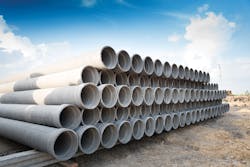Leveraging AI to Address AC Pipe in Drinking Water Distribution Systems
At one time in the United States, the use of asbestos cement (AC) pipe in drinking water distribution systems was very popular. It was first installed as early as the 1930s with the peak of installation in the mid-20th century. It was used because of its light weight, low coefficient of friction and resistance to corrosion. Unfortunately, it was later discovered through scientific studies that people who consume water with high amounts of asbestos over extended periods may face an increased risk of developing benign intestinal polyps and an increased risk of cancer, including mesothelioma. Because of this, the U.S. Environmental Protection Agency (EPA) promulgated regulations to monitor the level of asbestos in drinking water.
Under the Safe Drinking Water Act, asbestos is limited to 7 million fibers per liter (MFL) of water. There are several notable cases of AC pipe failure and potential health issues from detection of high levels of asbestos in the drinking water. The Town of Woodstock, NY experienced AC pipe issues in 1985.1 Devin, Texas, detected higher than normal asbestos levels in its water in 2016.2 Schools in Arp, Texas, faced issues with AC pipe last year.3 Eventually the concern over asbestos in drinking water ended new installation of AC pipe in drinking water systems, but it didn’t necessarily require, or lead to, the replacement of existing AC pipe.
There are thousands of miles of AC pipes still in the ground today, and many of them have reached or are reaching the end of their lifecycle, leading to potential problems for water consumers. An HDR Engineering study estimated more than 600,000 miles of AC pipe are installed in the U.S. and Canada, with a typical design life of 50 years.4 In addition, AC pipe can contain as much as 12 percent asbestos fiber content. In its Buried No Longer (BNL) initiative, the American Water Works Association (AWWA) estimated average life expectancy for AC pipe across the U.S.5 On the West Coast, for example, the average life of AC pipe is estimated at 65-105 years, depending on a “long service life” or “short service life” assumption.
Pipe break rates are one indicator of the condition of water pipes in a distribution network. A Utah State University study showed U.S. break rates for cast iron (CI) pipe at 35/100 miles/year, an increase of 43 percent over the past 6 years.6 While CI pipe break rates are high, AC pipe break rates are also significant and are increasing dramatically (the same study showed U.S. break rates for AC of 10/100 miles/year, an increase of 46 percent over the past 6 years). More disturbing among engineers is that while CI pipe failures usually start small (with just a pinhole leak) and gradually grow to a full break, giving early warning before a catastrophic main break occurs, AC pipe often fails catastrophically when it first breaks without prior warning.
Asbestos cement pipe was originally used because of its light weight, low coefficient of friction and resistance to corrosion. Unfortunately, it was later discovered that people who consume water with high amounts of asbestos over extended periods may face an increased risk of developing benign intestinal polyps and an increased risk of cancer, including mesothelioma.
Addressing the AC Pipe Challenge
So, how does a utility address aging AC pipe? There are four basic alternatives for thorough management of AC water mains:
1. Total AC pipe replacement: With this approach, the end result is that there is no AC remaining, so the entire risk has diminished. However, a typical cost for total replacement is $1M/mile and the process can take as long as 50-100 years.
2. Engineering-driven desktop condition assessment: This strategy ensures your pipes will be thoroughly reviewed by a professional engineer who is trained and experienced in condition assessment. But, it can take as long as 2-3 years to execute and cost in the range $3,000-5,000/mile of water main. Desktop condition assessments are substantially built on age and break history of the pipes, and thus aren’t optimal to predict “first” breaks. Also, desktop assets are based on arbitrary assumptions and weights (i.e., older pipes are more in need of replacement than newer pipes). As mentioned earlier, this is not always the case. More advanced statistical modeling may help decipher differences between various variables, although many of these approaches may not have the ability to consider the importance of some adjacent details such as proximity to light rails or the contribution of elevation or pipe material, therefore impacting its accuracy.
3. Pipe-level, detailed physical condition assessment: This results in a very accurate and reliable assessment of the pipe tested and may only take a few months. However, costs can range from $20,000 to $50,000/mile, and it only provides analysis on the specific chosen pipe. Physical condition assessments tend to be labor intensive and multiple physical measurements are required for correlation and confirmation. The results are difficult to extrapolate to system-wide recommendations. Moreover, one must be careful not to disturb the integrity of the AC pipe during testing.
4. Digital condition assessment using artificial intelligence (AI), specifically machine learning: Machine learning consumes large, complex data sets containing more variables than humans can process with current tools. This objective, data-driven method overcomes human limitations with their inherent subjectivity and biases and provides results that help utilities make effective AC pipe replacement decisions. A commercially available off-the-shelf (COTS) digital condition assessment solution using machine learning can provide a condition assessment of an entire water distribution system in 4-8 weeks at a cost of less than $100 per mile.
For some water utilities with manageable amounts of AC pipe, the first approach can make sense: just replace all the AC pipe. For utilities with available time, funding and engineering resources, the second approach may be the way to go. The third alternative is best suited for large transmission pipes that can’t be allowed to “run to failure.” For many utilities, the fourth approach, using data-driven machine learning, can be a very fast, accurate and affordable approach for a full, system-wide analysis that can then be used to prioritize the AC pipe for replacement, leak detection or valve maintenance, or further detailed analysis.
Technology company Fracta (Redwood City, Calif.) is currently working with over 30 U.S. water utilities on condition assessments of their potable water systems using its proprietary COTS digital water main condition assessment software. It calculates and visualizes the Likelihood of Failure (LoF) for every water pipe segment. The LoF score represents the mathematical probability of a pipe failure and, used in conjunction with Consequence of Failure (CoF), level of service, hydraulic modeling, etc., can support AC pipe replacement decisions.
Fracta’s proprietary COTS digital water main condition assessment software calculates and visualizes the Likelihood of Failure (LoF) for every water pipe segment in a given network.
Case Study: EBMUD
East Bay Municipal Utilities District (EBMUD, Oakland, Calif.) has been working with Fracta since 2016. Via approximately 4,200 miles of pipe, the agency supplies water to 1.4 million EBMUD customers across a 332-square-mile area. The pipes are comprised of buried cast iron (35 percent), asbestos cement (30 percent), steel (26 percent), and PVC (9 percent). Historically EBMUD has replaced about 10 miles of distribution pipe per year. The approach to selecting the projects was reactive, replacing only pipes that had broken many times before. Although EBMUD’s main break rate was within industry standards, the failure rate was increasing.
EBMUD created the Pipeline Rebuild program in 2014 to increase the replacement rate in a cost-effective, efficient, and sustainable manner with a primary goal of decreasing the annual break rate. In 2016, EBMUD began selecting replacement projects by evaluating risk, and increased its pipe replacement rate to 15 miles per year. In the coming years, EBMUD will ramp up its annual replacement rate to 20 miles. With a large inventory of aging cast iron and asbestos cement pipe, EBMUD’s risk analysis is increasingly proactive and strategic in determining the right pipes to replace.
In 2016, Fracta modeled EBMUD’s 4,200 miles of drinking water pipes and subsequently commercialized its Pipeline Condition Assessment model in 2017. During the five-year period from 2012-2016, the LoF-predicted breaks from the Fracta model were compared to the actual breaks experienced by EBMUD. The predicted results were within 10-15% of the actual results. EBMUD is now using Fracta as a supplemental tool for selecting which pipes to replace.
Summary
AC pipe poses a long-term risk to water utilities and the communities they serve. With thousands of miles of AC pipe approaching the end of its useful life, utilities cannot wait much longer to take action. It’s logistically and economically infeasible to replace all the AC pipe in the short to medium term. Instead it is better to assess the condition of each pipe segment and, based on the likelihood and consequence of failure, prioritize replacement decisions.
Digital condition assessment tools using machine learning are commercially available. They offer a fast, accurate and affordable alternative for identifying AC pipe failure risk as compared to traditional desktop and physical assessment methodologies. Incorporating the use of such tools in a proper AC pipe management program a can contribute to the reduction of health risks and related socioeconomic impacts incurred from aging and deteriorating AC pipe. WW
References
1. Prose, Francine. “Woodstock: A Town Afraid to Drink Water,” New York Times, April 13, 1986.
2. “Mandatory Language for a Maximum Contaminant Level Violation: MCL, Average/Asbestos,” City of Devine, Texas, November 28, 2016.
3. Rivers, Brionna. “Arp ISD takes extra precautions after high levels of asbestos reported in city’s water,” KLTV, August 18, 2017.
4. Williams, G. Eric and Kent Von Aspern. “Asbestos Cement Pipe: What If It Needs to Be Replaced?” HDR Engineering, presentation delivered at Underground Construction Technology Conference, Atlanta, Ga., 2008.
5. “Buried No Longer: Confronting America’s Water Infrastructure Challenge,” American Water Works Association (AWWA) Water Utility Council, 2012.
6. “Water Main Break Rates in the USA and Canada: A Comprehensive Study,” Utah State University, March 2018.
Circle No. 247 on Reader Service Card
About the Author

Lars Stenstedt
Lars Stenstedt is co-founder and COO of Fracta. He brings more than 25 years of sales, business development and engineering experience, with a focus on big data and cloud computing environments. He holds a Bachelor of Science in mechanical engineering from Stanford University and an MBA from the Haas School of Business, University of California, Berkeley.


